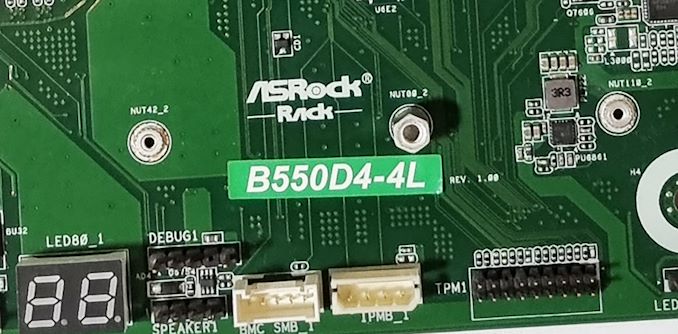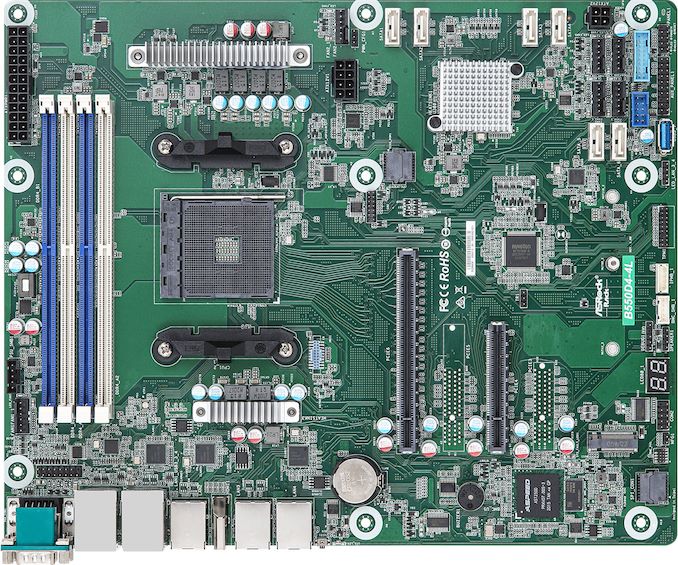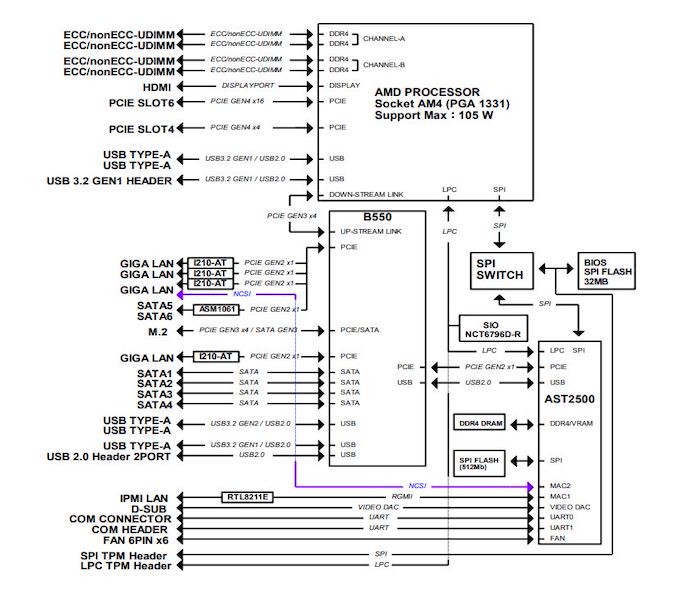ASRock Rack B550D4-4L Motherboard Review: B550 Goes Professional with BMC
by Gavin Bonshor on May 20, 2021 9:00 AM EST
Over the last year, we've seen several B550 models, with the vast majority of these catering to desktop users and gamers looking for a cost-efficient option to use with AMD's Ryzen processors. Back in January, we reported that ASRock Rack had readied up a new B550 model with a more professional flavor, the B550D4-4L. The B550D4-4L features support with a broad range of AMD Ryzen processors, including 5000, 4000G, and 4000 Pro, with support for most 3000 series processors. Some of the board's core features include Gigabit Ethernet, support for 128 GB of DDR4 memory, and an ASPEED BMC controller for management over a network. We get to grips with the ASRock Rack B550D4-4L and see how it compares to other AM4 models in our latest motherboard review. It came with a few surprises as well.
ASRock Rack B550D4-4L Overview
Perhaps considered one of the most 'interesting' motherboards based on the B550 chipset is the ASRock Rack B550D4-4L. At the time of writing, the B550D4-4L is the only B550 board known to us that includes a BMC controller. It is designed to utilize the power and high-core count of AMD's Ryzen 5000 and 3000 desktop processors, with support also available for AMD's Ryzen Pro 4000 series and some Pro 3000 Processors.

The ASRock Rack B550D4-4L has a transposed AM4 socket and transposed memory slots
Looking at the overall design, it is focused on professional use and uses a standard green PCB. The B550D4-4L opts out of fanciful aesthetics and instead focuses on core functionality. Along the top is four memory slots which are horizontally mounted, with support for up to 128 GB DDR4-3200, both ECC with supported Ryzen Pro processors and non-ECC memory on the regular Ryzen desktop models. The B550D4-4L has one full-length PCIe 4.0 x16 slot and one half-length PCIe 4.0 slot. For storage, there's just one M.2 slot but is only capable of supporting PCIe 3.0 x4 or SATA drives, as well as six SATA ports, four from the chipset and two from an ASMedia controller.
The rear panel has four Intel Gigabit Ethernet ports, with a fifth Ethernet port for the board's ASPEED BMC controller, allowing remote access to the system over a network. Other connectivity includes an HDMI output for use with processors with integrated graphics and a D-Sub output (DB15) for the BMC, and four USB Type-A ports, two USB 3.2 G2, two USB 3.2 G1. ASRock Rack also includes a serial connector (DB9). The B550D4-4L also has a USB 3.2 G1 header providing a further two ports, a USB 2.0 header for two ports, and six 6-pin fan headers.
ASRock B550D4-4L Block Diagram
Looking at performance, the B550D4-4L was surprisingly competitive in our computational-focused benchmarks, with the board using AMD's Precision Boost Overdrive at default. This is above simply doing a good turbo, making the board perform a lot better than we would assume.
One downside in performance was perhaps the memory - it ran at DDR4-3200 CL22 as opposed to other B550 models we tested at DDR4-3200 CL16, and no matter what values we put in for the latencies, they stayed at JEDEC CL22.
The B550D4-4L also proved competitive in our system testing, with faster than expected POST time performance. It showed lower power consumption in long idle and idle power states than most boards, while power consumption at load was comparable with other models on test. The board's DPC latency performance isn't great, but it doesn't include any form of audio codec or audio output regardless.
The ASRock Rack B550D4-4L is a unique B550 model, with not much competition in the way of server-focused models. ASRock also has a model based on the propriety deep mini-ITX form factor, the B550D4ID-2L2T, which uses the B550 chipset for more professional level function. Unlike other B550 models, the B550D4-4L disables overclocking, which is understandable given its lack of heatsink capability on the power delivery, highlighting that this board isn't for pushing the boundaries or requires a system with strong airflow.
The real capability comes for users looking to build a Ryzen desktop-based server with the associated performance levels at default settings, along with added functionality for both Ryzen Pro series processors and the ASPEED BMC controller allows access and control of the system remotely. It's also the only B550 model to feature four dedicated Ethernet controllers, and it makes it one of the most interesting AM4 models we've received for review so far.
Read on for our extended analysis.











73 Comments
View All Comments
im.thatoneguy - Thursday, May 20, 2021 - link
Please stop putting 10g ports one servers.They're always 10-BaseT which is useless to me. They take up pcie lanes. And 25gb/40gb/100gb is imminently supplanting 10gb.
It's too late for 10g especially baseT
fmyhr - Thursday, May 20, 2021 - link
Heh. I agree with you about 10-BaseT, SFP+ would be preferable if 10GbE *needs* to be present. I don't have $ or power budget for 25gb/40gb/100gb network... but understand those are requirements for some. I'm curious how your ideal board would allocate its limited PCIe lanes among PCIe slots, M.2 slots, OcuLink,...?bananaforscale - Saturday, May 22, 2021 - link
10GBase-T uses the same cabling as 1000Base-T, assuming the network was built with any future proofing so you can basically just plug it in. 25GBase-T probably won't happen. 'sides, YOU are not the market. What's useless to you is probably useful for someone. Also besides, you can disable those integrated NICs.mode_13h - Saturday, May 22, 2021 - link
> 10GBase-T uses the same cabling as 1000Base-T,> assuming the network was built with any future proofing
Depends on when. It might've been built with Cat 6, rather than Cat 6A. And even that has shorter length limitations and requires greater power expenditure than we're used to with Gigabit.
BTW, there's no such standard as Cat 6e. If you see someone selling cable as Cat 6e, treat it as plain Cat 6, but with a bit more suspicion.
Samus - Thursday, May 20, 2021 - link
I think 2x2.5G would be more appropriate for the target market of this board. Anybody considering 10Gbe is likely on the verge of adopting 25/40/100G anyway, in which case the PCIe slot will be utilized.The other head scratcher is why the M2 slot isn’t PCIe 4.0 - the allocation of PCIe lanes to ports on this board is very strange.
fmyhr - Thursday, May 20, 2021 - link
Do you have personal experience running 2.5GbE? I've seen reports of problems using both Intel and Realtek chipsets. Whereas 10GbE is very mature and well-supported. Upside of being "obsolete" :-)This board runs the M.2 slot from the B550 chipset, which limits its speed to PCIe 3.0. The upside of this choice is an extra PCIe 4.0 x4 slot from the CPU. Into which you could install an M.2 carrier board if you need your SSD on PCIe 4.0. Personally I'd try bifurcating the PCIe 4.0 x16 slot and running a quad M.2 card there, and whatever other PCIe card in the x4 slot.
lightningz71 - Thursday, May 20, 2021 - link
Does this board even support 4way bifurcation of the PCIe x16 slot?Samus - Friday, May 21, 2021 - link
The B550 can't bifurcate the x4 slot, but it apparently can the x16 slot. In the case of some boards with multiple PCIe 4.0 NVMe M.2 connectors, they start by cutting the x16 slot bandwidth, then after a third M.2 drive is installed they either totally disable the x4 slot or run the x16 slot at x4, configurable in the BIOS (in the case of the Gigabyte B550 Aurus Master)Samus - Friday, May 21, 2021 - link
Personally no I'm not running any 2.5G stuff, and based on what you are stating, maybe that's why there hasn't been adoption. I agree going with a mature solution but 2.5G isn't exactly new and by now you'd think the bugs are worked out. 2.5G is, after all, based on a lower handshake of 10Gbe, and at long distances 10Gbe actually negotiates at 2.5G, and I have installed 2.5G cards in the field that connect to 10Gbe ports at 2.5G. It's the damn SFP adapters that are all proprietary with their individual standards so you just need to make those up with whatever chipset the NIC you are connecting has.Regarding NVMe on B550, I'm not sure what you are getting at. There have been B550 boards on the market for over a year that have not one, not two, but three native PCIe4 NVMe M.2 slots direct from the chipset. Obviously having many M.2 slots impedes on other PCIe x4\x8\x16 slot bandwidth because the consumer Ryzen's don't offer many lanes. But that doesn't mean this board should leave support out entirely as the M.2 could just cut into the x4 or x16 slot bandwidth.
mode_13h - Friday, May 21, 2021 - link
> Do you have personal experience running 2.5GbE?Well, the main benefit is cable length and compatibility. If the speed is fast enough for you, then it seems an attractive option for those with legacy cabling.